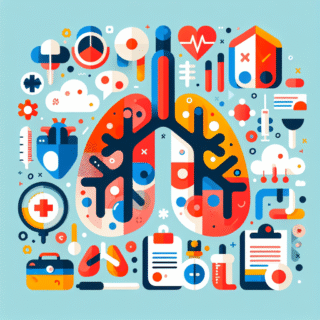
More Allergy, Asthma & Infectious Disease Articles
Understanding Different Lung Conditions: A Patient’s Guide

Breathing is automatic, so we often don’t think about our lungs until symptoms appear. This guide explains lungs conditions in clear, patient-friendly terms so you can recognize signs, understand common causes, and know when to seek care. Knowing the basics helps you discuss tests and treatments with your healthcare team and take practical steps to protect respiratory health.
lung conditions: a quick overview
“Lung conditions” is an umbrella term for disorders that affect the airways, lung tissue, blood vessels, or the chest cavity. They range from short-term infections to chronic diseases that require long-term management. Awareness of types of lung conditions and their typical progression helps in early detection and effective treatment.
Common types and names of lung conditions
There are many different lung conditions. Below are some of the most common lung conditions you might hear about:
- Asthma — a chronic airway inflammation causing wheeze, cough, and variable breathlessness.
- Chronic obstructive pulmonary disease (COPD) — includes emphysema and chronic bronchitis, usually from smoking or long-term exposure to irritants.
- Pneumonia — infection of the lung tissue that may be viral, bacterial, or fungal.
- Lung cancer — malignant growths in lung tissue that often require combined treatments (surgery, radiation, chemotherapy).
- Interstitial lung disease and pulmonary fibrosis — scarring of lung tissue that reduces oxygen transfer.
- Acute bronchitis — inflammation of the bronchial tubes, often following a cold or flu.
- Pulmonary embolism — a blood clot in a lung artery, which is a medical emergency.
- Pleural effusion and pneumothorax — fluid or air in the chest cavity that can compress the lung.
How different lung conditions present
Symptoms overlap across many names of lung conditions, but patterns help clinicians narrow the cause. Common symptoms include persistent cough, chest discomfort, wheezing, shortness of breath, coughing up blood, and unexplained fatigue or weight loss.
- Sudden severe shortness of breath and chest pain: think pulmonary embolism or pneumothorax.
- Fever, productive cough, and localized chest pain: more consistent with pneumonia or severe bronchitis.
- Intermittent wheeze and cough triggered by exercise, cold air, or allergens: suggests asthma.
- Long-term exertional breathlessness and chronic cough in a smoker: consider COPD or lung cancer.
Diagnosis and tests
Doctors use history and physical exam plus targeted tests to identify types of lung conditions. Common diagnostic tools include chest X-ray, CT scan, spirometry (breathing tests), pulse oximetry, arterial blood gas tests, sputum cultures, and sometimes bronchoscopy or lung biopsy for tissue diagnosis. For reliable general guidance on respiratory health and prevention, reputable public health resources can be helpful — for example the CDC’s lung disease information pages.
CDC: Information on lung diseases and conditions
Treatment approaches
Treatment depends on the diagnosis. Acute infections may need antibiotics or antivirals and supportive care. Asthma and COPD are managed with inhaled medications (bronchodilators, steroids), smoking cessation, pulmonary rehabilitation, and oxygen therapy when needed. Cancer treatments vary by type and stage and can include surgery, systemic therapy, and radiation. Pulmonary embolism often requires anticoagulation or interventional procedures. For interstitial lung disease, anti-fibrotic drugs and symptom management may be recommended.
Prevention and self-care
Many types of lung conditions are preventable or manageable with lifestyle choices and vaccinations. Key steps include:
- Not smoking and avoiding secondhand smoke; reduce occupational exposures to dusts, chemicals, and fumes.
- Staying up to date on vaccines (influenza, pneumococcal, and others when recommended) to lower infection risk.
- Regular physical activity and pulmonary rehabilitation for chronic disease to improve function and quality of life.
- Following treatment plans and seeing your clinician when symptoms change or worsen.
For guidance on preventing infections from food or other sources that can complicate lung disease or overall health, see detailed resources such as the article on how salmonella infections happen and how to avoid them.
How Salmonella Infections Happen and How to Avoid Them
When to seek medical care
Seek immediate care for sudden severe breathlessness, chest pain, fainting, or high fevers. Make an appointment for persistent cough, changes in sputum, unintentional weight loss, or progressive shortness of breath. Early diagnosis of many names of lung conditions improves outcomes.
- Takeaways:
- Understand that “lung conditions” cover infections, chronic diseases, and structural problems of the chest and airways.
- Common lung conditions include asthma, COPD, pneumonia, pulmonary embolism, and lung cancer — each with different treatments.
- Early evaluation, smoking cessation, vaccinations, and following treatment plans reduce risk and improve quality of life.
- Use trusted sources and your healthcare team to guide testing and long-term care decisions.
FAQ: What causes chronic lung disease?
Chronic lung disease is often caused by long-term exposures such as tobacco smoke, air pollution, workplace dusts and chemicals, recurrent infections, or genetic factors. Managing exposures and early treatment can slow progression.
FAQ: Can most lung infections be prevented?
Many lung infections can be reduced through vaccines (like flu and pneumococcal vaccines), good hand hygiene, avoiding sick contacts when possible, and safe food practices. Prompt care for respiratory symptoms also helps limit complications.
FAQ: How do I know when breathing problems are an emergency?
Call emergency services or go to the nearest emergency room for sudden severe shortness of breath, difficulty speaking, chest pain, fainting, or if lips or face turn blue. These signs can indicate life-threatening lung or heart problems.
Other Articles You May Find of Interest...
- What You Need to Know About Managing MCAS Rash Symptoms
- Can Hepatitis B Be Cured? Exploring Treatment Options and Outcomes
- Perfecting Your Neti Pot Experience: The Ideal Salt Water Ratio for Optimal Results
- Is Sighing Dyspnea a Sign of a Greater Health Issue?
- Pleurisy: Understanding Causes, Symptoms, and Treatment Options
- Chills Without Fever: What Causes Them and Should You Be Concerned?
- Effective Solutions for Rid Lice Treatment: What Works Best?














